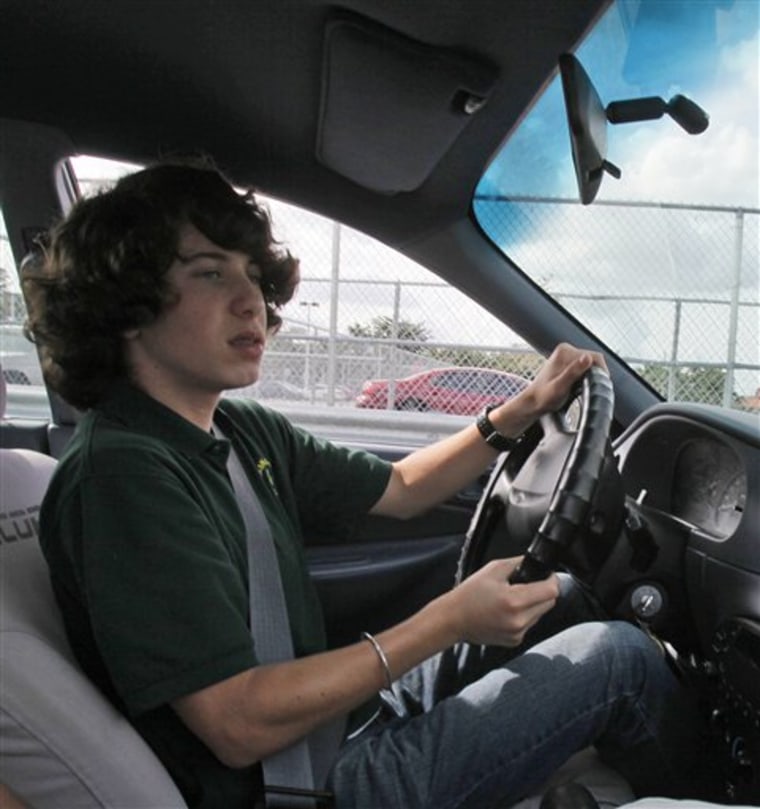Beginning driver Ashley Crawford grips the worn gray steering wheel and warily begins maneuvering the 1999 Ford Escort through a set of bright orange traffic cones outside Killian Senior High School.
She considers herself lucky: Because of budget cuts, many schools around the country are leaving driver's ed by the roadside. They are cutting back on behind-the-wheel instruction or eliminating it altogether, leaving it to parents to either teach their teenagers themselves or send them to commercial driving schools.
"If my parents would have taught me, it would have been different," said Ashley, a 16-year-old sophomore. "When I drive, they try to tell me what to do, and I get nervous."
Some educators and others worry that such cutbacks could prove tragic.
"As soon as people start taking driver's education away from the kids, we're going to pay for it with lost lives, collisions, and ultimately that costs everybody," said John Bolen, past president of the Florida Professional Driving School Association.
Some worry also that many parents can't afford the $350 to $700 that private lessons can cost or don't have the skills to teach their kids themselves. Even for those who can do it, the combination of parents, teenagers and learning how to drive can be volatile.
In more than half the states, minors who want a license must take driver's education from a certified instructor, said Allen Robinson, CEO of the American Driver and Traffic Safety Education Association. However, that doesn't necessarily mean schools are required to offer a class. Generally, after age 18, would-be drivers do not have to undergo any formal instruction.
'Financial pressure'
High schools started rolling back driver's ed after their effectiveness was called into question in the 1980s. The more recent cutbacks have been driven by school funding shortages, and the trend might be accelerating because of the downturn in the economy, said J. Peter Kissinger, president and CEO of the AAA Foundation for Traffic Safety.
Robinson said the nation's schools have all but eliminated driver's ed as an elective course offered during the school day.
Here in Miami-Dade County, the nation's fourth-largest school system got rid of driver's ed during the day at all but Killian and another school. Students can still enroll in a free after-school course at one of the district's adult education centers. But that is not an option for the many thousands of students who play sports or are involved in other extracurricular activities, or cannot get a ride.
About 10 high schools in Georgia eliminated or reduced driver's education this school year. A dozen more did the same in Kansas last year. In Volusia County, Fla., schools eliminated daytime driver's ed three years ago, replacing it with summer, after-school and Saturday classes. Enrollment plummeted two-thirds, saving about $400,000 a year.
"This is not because they don't believe in driver's ed," said Bob Dallas, director of the Georgia Governor's Office of Highway Safety. "They do, but they're facing the same financial pressure that everybody in government is facing."
Budget woes
In rural Pennsylvania, the Titusville district got rid of the behind-the-wheel portion of its program last spring, saving about $20,000. In Blountville, Tenn., the driver's education program was cut in half about five years ago because of budget problems. Administrators considered eliminating the $130,000-a-year program last spring, but did not.
"It could save lives. It's very simple," said Jack Barnes, director of schools in Sullivan County, Tenn. "We don't want any of our students injured or killed because of mistakes they made that possibly a program like this could help."
Motor vehicle crashes are the leading cause of death for U.S. teens; in 2007, an average of 11 16- to 19-year-olds died every day. But Russ Rader, a spokesman for the Insurance Institute for Highway Safety, said studies show there is no difference in crash risk between 16- and 17-year-olds who take driver's ed and those who don't.
"In some cases, driver's education has a negative effect because in some states you can get a license sooner if you take driver's ed," he said.
'It's all business'
Private instructors aren't necessarily picking up all the students who can't take driver's ed at school.
Julio Torres, an instructor at the Easy Method Driving School in Miami, said he suspects the downturn in the economy is playing a role. He also said some parents simply prefer to teach their kids.
But Torres and others said parents, despite their best intentions, aren't always the best instructors. For one thing, they may pass their own bad driving habits on to their children.
Also, "the kids are at a stage where they're confrontational with their parents," said Brenda Bennett, owner of a driving school in Erie, Pa., that holds contracts to teach driver's ed through some area high schools. "Then you add driving with a parent and you have more confrontation. Whereas someone like myself, when we take kids out, there's no personality going there. It's just all business."
